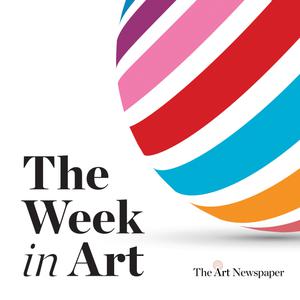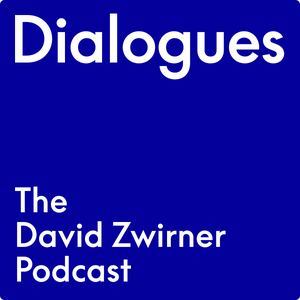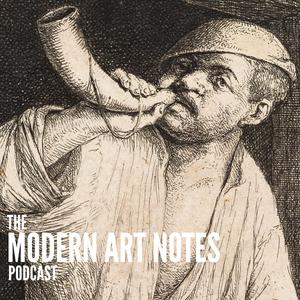
The Art Angle
Artnet News
- 46 minutes 1 secondThe Art Angle Roundup: On the Ground at the Venice Biennale
It is time for another edition of the Art Angle Roundup, where we look at some of the biggest headlining stories of the past month. But really, let's be honest, in the art world there's just one headlining story, and that is the 60th edition of the Venice Biennale, the so-called "Olympics of the Art World," which opened to the public last Saturday, April 20.
Brazilian curator Adriano Pedrosa's "Foreigners Everywhere" was a major feat, and it brought together more than 330 artists and collectives, the vast majority of whom have not been seen at the Biennale before. So it was truly exciting. And all over Venice, there were scores of collateral shows, galleries that brought their own exhibitions, private foundations pulling their weight as well with all of their palazzos.
Suffice to say, the lagoon was busy.
As we know, it's a challenge to get anywhere fast in a city without cars and bikes, and it's very easy to get lost along the way, but there is, naturally, a lot of great art to see. This week, Art Angle co-hosts Kate Brown and Ben Davis are joined by acting Editor in Chief Naomi Rea, who were all together at the vernissage and are now back to remotely chatting from Berlin, New York, and London respectively.
After a very busy week, a look back at what it was like on the ground in Venice, beginning with the main show curated by Pedrosa (who was a recent guest on the podcast); the protests that took place around the Biennale art week; and finally the national pavilions, the nation-state pavilions, and all of the hits, misses, and stories that came out of it.
25 April 2024, 9:10 pm - 45 minutes 23 secondsWhy Are Art Resale Prices Plummeting?
The art press is filled with headlines about trophy works trading for huge sums: $195 million for an Andy Warhol, $110 million for a Jean-Michel Basquiat, $91 million for a Jeff Koons. In the popular imagination, pricy art just keeps climbing in value—up, up, and up. The truth is more complicated, as those in the industry know. Tastes change, and demand shifts. The reputations of artists rise and fall, as do their prices. Reselling art for profit is often quite difficult—it’s the exception rather than the norm. This is “the art market’s dirty secret,” Artnet senior reporter Katya Kazakina wrote last month in her weekly Art Detective column.
In her recent columns, Katya has been reporting on that very thorny topic, which has grown even thornier amid what appears to be a severe market correction. As one collector told her: “There’s a bit of a carnage in the market at the moment. Many things are not selling at all or selling for a fraction of what they used to.” For instance, a painting by Dan Colen that was purchased fresh from a gallery a decade ago for probably around $450,000 went for only about $15,000 at auction. And Colen is not the only once-hot figure floundering. As Katya wrote: “Right now, you can often find a painting, a drawing, or a sculpture at auction for a fraction of what it would cost at a gallery. Still, art dealers keep asking—and buyers keep paying—steep prices for new works.” In the parlance of the art world, primary prices are outstripping secondary ones.
Why is this happening? And why do seemingly sophisticated collectors continue to pay immense sums for art from galleries, knowing full well that they may never recoup their investment? This week, Katya joins Artnet Pro editor Andrew Russeth on the podcast to make sense of these questions—and to cover a whole lot more.
18 April 2024, 9:10 pm - 45 minutes 24 secondsWhy Adriano Pedrosa Sees His Venice Biennale As 'Paying a Debt'
Next week, the art world will descend into the Venetian Lagoon for the Venice Biennale, the most highly anticipated art event of this year. The Brazilian curator Adriano Pedrosa is at the helm of the prestigious group exhibition, which is now in its 60th edition, and his show includes more than 300 artists and collectives presented in the historic Arsenale and the Central Pavilion in the Giardini. Many of these artists, who are largely based or from the global South, are on view for the first time in these revered spaces.
There are multiple ways to look at the show and its title "Foreigners Everywhere," which is inspired by a famous work of the same name by artist collective Claire Fontaine. It is both an acknowledgement of the artistic positions of exile of the immigrant or outsider, but also importantly asks of the audience to think about who exactly is a foreigner... and who is not. Pedrosa argues that deep down we are all foreigners, and this exhibition, which the curator describes as a "provocation," arrives as the world is facing a multitude of emergencies centered around the very concepts of exile and belonging.
Just as everything was coming together over the last weeks ahead of the April vernissage, Artnet's Kate Brown spoke to Pedrosa about what visitors can expect from "Foreigners Everywhere" and his overarching vision for the show. He shared his views on how one should navigate an exhibition of this scale, and discusses his background as a curator in São Paulo, which included organizing pioneering exhibitions of marginalized perspectives and histories during Jair Bolsonaro's populist reign in Brazil. The two also speak about Pedrosa's understanding of what it means to be a foreigner from both a political and artistic perspective.
11 April 2024, 9:10 pm - 49 minutes 11 secondsTwo Critics on the Whitney Biennial
Every two years, the Whitney Museum of American Art returns with its signature and much-anticipated biennial. Founded in 1931, the Whitney Biennial is one of the most historically important art events in the United States, a survey that brings together artists from throughout the country, and more recently, from around the world. Often controversial, the Whitney Biennial is viewed by art fans as more than just a show to enjoy. It is closely scrutinized as a statement about art now.
Well, the 2024 edition of the Whitney Biennial has just opened here in New York, with the title “Even Better Than the Real Thing.” It is curated by Meg Olni, a curator-at-large, and Chrissie Iles, a veteran Whitney curator. It features just a little more than 40 artists laid out across the museum's galleries. Artnet's critic Ben Davis has written a take on the 2024 Whitney Biennial for Artnet—and so has Danielle Jackson, a critic and Artnet contributor. So, how does this show feel, how does it stack up to previous editions, and what does it all mean? Two art critics got together to hash it all out.
4 April 2024, 9:10 pm - 36 minutes 43 secondsThe Art Angle Roundup: Damien Hirst's Formaldehyde Fail, a Photo Star Rediscovered, and Artnet News Turns 10
Well, it is the end of March, spring has sprung, and April showers are coming in fast and furious. We're back with the monthly Art Angle Round Up, where we focus our attention on three headline-making stories that have made the rounds in the last month. This week, Art Angle hosts Ben Davis and Kate Brown are joined by Artnet brand editor William van Meter.
First up is the latest from controversy-machine Damien Hirst. The former YBA enfant terrible is back in the news for fudging the dates of his signature formaldehyde animal series, which itself follows the news from a few years ago that those same sculptures "leaked noxious gas." Next up is a conversation about the International Center of Photography (ICP), which celebrates its 50th anniversary this year. Ben's story, titled "How Do You Tell Photography’s History? ICP’s Big Birthday Show Embodies the Struggle" and William's "The Exquisite Life of Photographer David Seidner" broach larger questions about what ICP's vision is as a photography museum and more broadly address the state of photography today. Finally, it's our birthday! In February, we marked 10 years of Artnet News, and the trio revisits some of the biggest stories published over the last decade, and the future of art media.
28 March 2024, 8:10 pm - 40 minutes 39 secondsA Peek Behind the Curtain at Auction Houses
A few years back, electrifying bidding wars and monumental transactions routinely had us all on the edge of our seats in the auction room, but this sort of in-room excitement now feels a long way off. Although you wouldn't necessarily know it from the triumphant post-sale press releases that are just as routinely put out by the auction houses who are keen to signal confidence in the market and, of course, in their performance. But in 2023, there's no denying that the art market finally came back down to earth.
It took a breather for a combination of reasons, including rising interest rates, geopolitical uncertainty, and let's not forget the crypto crash. But the point is not to wax poetic about the state of the art market because Artnet's Intelligence Report is all about data, and we have the numbers to back it up.
Let's refresh with some top line figures: The average price of a fine artwork sold at auction last year dropped almost 16 percent from 2022. Total fine arts sales generated by the big three auction houses—that's Sotheby's, Christie's, and Phillips—dropped 23 percent year over year. And the total spent on fine art at auction in 2023 is down 12.7 percent.
This week we have two speakers here to pull back the curtain on the findings of the latest Intelligence Report, from a conversation first recorded exclusively for Artnet Pro members. First, is Artnet's investigative journalist Katya Kazakina, who won a 2023 National Arts and Entertainment award from the Los Angeles Press Club for her cover story of the last Intelligence Report.
Her feature story this time around is just as fascinating. It delves into the Oscar-worthy performances of those very auction houses. To the casual observer (and often, even to those in the art world) it's not that obvious how the houses carefully stage manage their proceedings and, sometimes, even the results. The practice has become all the more insidious following the repeal of a set of laws governing the auction houses in New York City. The second guest this week is Margaret Carrigan, another sharp market mind and the editor behind our insightful Artnet Pro newsletter "The Back Room."
Read the full story at the heart of Katya and Margaret's conversation, and the entire Intelligence Report, now.
21 March 2024, 9:10 pm - 48 minutes 28 secondsA Reporter Goes Undercover in the Art World
The contemporary art world is nothing if not confusing. It is simultaneously deeply frivolous, and takes itself way too seriously. Its business dealings combine total mystification with conspicuous consumption, and the exact mechanisms by which one type of art gets celebrated above another are very often impossible to figure out.
If you've ever struggled to make sense of it all, the journalist, Bianca Bosker's new book is worth picking up. It's called Get the Picture, A Mind-Bending Journey Among the Inspired Artists and Obsessive Art Fiends who Taught Me How to See, and it joins books like Anthony Hayden Guest's classic True Colors from 1998 and Sarah Thornton's Seven Days in the Art World from 2008, as an entertaining behind-the-scenes chronicle of art, though in a very different and maybe even more confusing moment. Bosker previously wrote Original Copies (2013) about architecture in China that replicates famous world monuments, and Cork Dork (2017), where she went inside the world of fine wine to try to decode its rituals.
For Get the Picture, Bosker inserted herself in the striving, less-visible layers of the art industry, just beneath the glamorous images. She works the booth at a satellite fair in Miami where a gallery's very survival hinges on a few sales. And as a studio assistant for a painter whose success becomes a major headache as speculators start flipping her work.
In some ways, Get the Picture will confirm all of the worst stereotypes about the contemporary art industry, and in others is the story of someone who slowly learns how to look past the caricatures by throwing herself into the thick of it, finding her own way to appreciate some of art's more eccentric values.
14 March 2024, 9:10 pm - 47 minutes 52 secondsJames Fuentes Has His Own Playbook for Success. It’s Working.
It has been 17 years since James Fuentes first hung a shingle out under his own name. In the years since, he has carved out a unique position in the contemporary art world, representing an eclectic mix of older, sometimes overlooked artists, alongside younger, buzzier names.
Prior to striking out on his own, Fuentes worked for a handful of high-profile gallerists, including Jeffrey Deitch, whose eye he first caught with an ambitious pitch for a reality television show about artists, an idea that was way ahead of its time, considering it was the early aughts.
Fuentes has long been a mainstay of the Lower East Side, which happens to be the same area where he grew up. Between his first smaller gallery on the appropriately named St James Place, and later at a larger location on Delancey Street, he has watched neighborhood undergo seismic shifts. Amid all of the changes, he still regards the Lower East Side as a thriving and incredibly diverse place to live and work.
Last year, Fuentes joined the ranks of East Coast dealers heading out West to open a gallery in the burgeoning art scene of Los Angeles. Just as he is set to mark the one year anniversary on Melrose Avenue, another major change is underway: a big move across town in Manhattan to the new gallery hub of Tribeca, into a 3,000-square-foot, ground-floor space on White Street.
This week on the podcast, senior reporter Eileen Kinsella caught up with Fuentes to talk about growing up in New York City during the heyday of hip hop and graffiti art, and his unique approach to the art business, alongside the broader growth and changes in the art world at large.
7 March 2024, 10:10 pm - 39 minutes 27 secondsThe Art Angle Roundup: Museums vs Patrons, a Contested Sculpture Stars in Venice, and Koons on the Moon
On this week's episode, hosts Ben Davis and Kate Brown are joined by the newly-minted Artnet Pro editor and veteran art journalist and critic Andrew Russeth. We're thrilled to have him as a part of our team, and he's making his Art Angle debut with another edition of the Round Up, where we discuss three topics making headlines and sparking conversation in and around the art world.
The first subject is the opening of The Dean Collection at the Brooklyn Museum, a show featuring the collection of Swizz Beatz and Alicia Keys titled "Giants," which is generating a lot of buzz for championing the works of Black artists including Kehinde Wiley, Ebony G. Patterson, Jordan Casteel, Henry Taylor, and Hank Willis Thomas, among many, many others. But that's not the only reason it's in the news. Andrew edited a piece by resident Art Detective Katya Kazakina titled "Should Museums Show Art Owned by Patrons? It's Tempting. It Can Also Blow Up" that investigates the fraught history of institutions doing just that. Though Swizz Beatz resigned as a trustee of the Brooklyn Museum three months before the show opened, "Public museums, critics argue, need to guard their curatorial independence and should not be used by wealthy patrons to boost the value of their holdings."
The next topic of conversation is about a long-standing issue of ownership and repatriation surrounding an ancestral sculpture from Africa that was bought and sold to the Virginia Museum of Fine Arts, where it has resided since 2015. A recent push by the art collective Cercle d’Art des Travailleurs de Plantation Congolaise (CATPC) has resulted in a temporary loan agreement in which the sculpture will be shown at a local gallery in the Democratic Republic of Congo, and simultaneously live-streamed to the Dutch Pavilion at the Venice Biennale.
Finally, on a lighter note, we turn to the recent news of Jeff Koons's art making its lunar landing after hitching a ride on the Odysseus Lander. Koons set a record in 2019 when his mirrored sculpture Rabbit fetched a total of $538.9 million, the most expensive price for a living artist at auction. In recent years though, his market has faltered, and the trio discusses if his moonshot will help send his prices back into the stratosphere.
29 February 2024, 10:10 pm - 51 minutes 2 secondsThe Roots of the Harlem Renaissance—and Its Power Today
The words the “Harlem Renaissance” have immense magnetism for vast numbers of people. In art history, however, the Harlem Renaissance has often been treated as a footnote to the main story of 20th century art. It’s often been given scant attention in textbooks, and even U.S. museums have historically given more attention to European movements of the 1920s, such as French Surrealism and Russian Constructivism, than to what was happening with Black artists in their own cities.
A new exhibition at the Metropolitan Museum of Art, called “The Harlem Renaissance and Transatlantic Modernism,” is out to correct the record. Curated by Denise Murrell, it places the explosion of creativity and experimentation by Black artists from the '20s to the '40s at the center of international art conversation in those years. The 160 works on view range from figures like Aaron Douglas and Jacob Lawrence, whose works have long been celebrated, to a host of less familiar names whose stories are not widely known. There’s so much to say about it.
To get some perspective on what makes this show such a big deal, art critic Ben Davis spoke to Bridget Cooks. Cooks teaches art history and African American studies at the University of California, Irvine, and is the author of Exhibiting Blackness, an important 2011 book about the history of U.S. museums’s relationship to Black artists. Cooks also happens to be one of a star group of experts who was on the Advisory Committee for this Met show. With “The Harlem Renaissance and Transatlantic Modernism” drawing major attention, they talked about both the history of the Harlem Renaissance itself and the history how museums have treated the subject in the past.
22 February 2024, 10:10 pm - 39 minutes 45 secondsInside the Art Fraud Feud of the Century
Last month, much of the art industry was transfixed on the goings-on in a courtroom in downtown Manhattan, where the Russian businessman Dimitry Rybolovlev and a group of Sotheby’s auction house representatives were taking turns on the witness stand.
The matter at issue was artworks that Rybolovlev had purchased via the Swiss art dealer Yves Bouvier. The Russian accused Sotheby’s of conspiring with Bouvier and defrauding Rybolovlev out of tens of millions of dollars in art sales and Sotheby’s denied any wrongdoing. The works in question are masterpieces, not least of which was Leonardo da Vinci’s Salvator Mundi. That work later made headlines for a totally different reason, when Rybolovlev sold it at Christie’s for $450 million in 2017
Rybolovlev ended up losing his case against the auction house last month, and the verdict is likely the last gasp in a high profile art fraud dispute that has travelled to courtrooms all over the world over the last years. And the Sotheby's trial this January was just part of a wider story that actually tracks back to a time before 2014 when the Russian businessman spent around $2 billion acquiring a world class art, collection of art by the likes of Paul Gaugin, Pablo Picasso and Henri Matisse. His right-hand man in getting him these works was Bouvier. Their relationship soured though when Rybolovlev discovered that Bouvier was marking up the prices. In some cases, Bouvier would speak with Sotheby's to get works evaluated After years of litigation in court actions, the two men eventually settled out of court in December, 2023.
While the details of their settlement are fully confidential, the proceedings with Sotheby's in January have shed light on the secretive world of our business dealings. Artnet’s Senior Editor, Kate Brown spoke about the case with Senior Market spoke with Eileen Kinsella, who has been following this dispute for years, since the very beginning and watched the trial in person last month.
15 February 2024, 10:10 pm - More Episodes? Get the App
Your feedback is valuable to us. Should you encounter any bugs, glitches, lack of functionality or other problems, please email us on [email protected] or join Moon.FM Telegram Group where you can talk directly to the dev team who are happy to answer any queries.
 The Week in Art
The Week in Art
 Dialogues: The David Zwirner Podcast
Dialogues: The David Zwirner Podcast
 The Great Women Artists
The Great Women Artists
 A brush with...
A brush with...
 The Baer Faxt Podcast
The Baer Faxt Podcast
 The Modern Art Notes Podcast
The Modern Art Notes Podcast